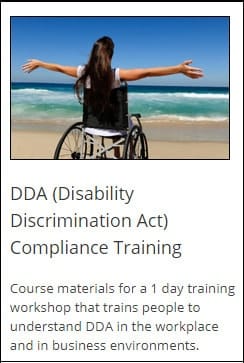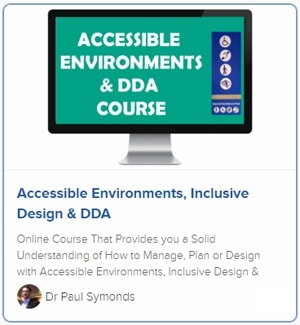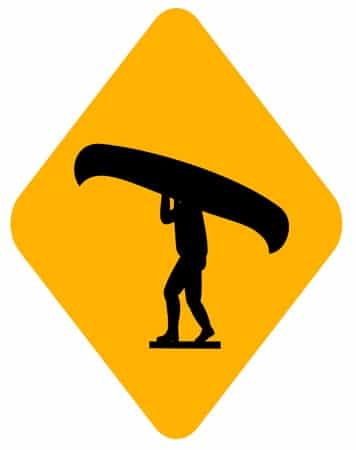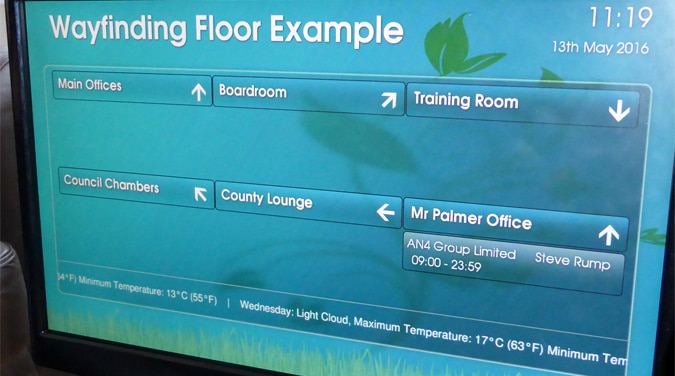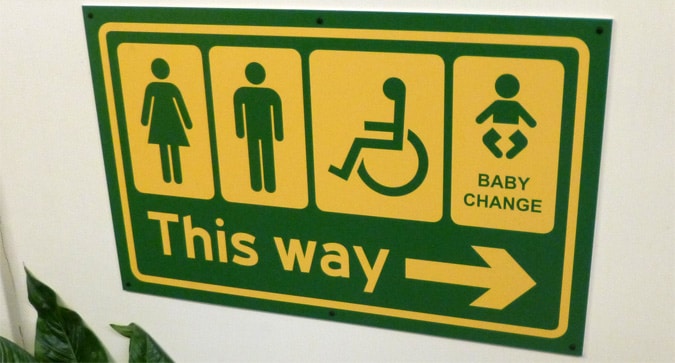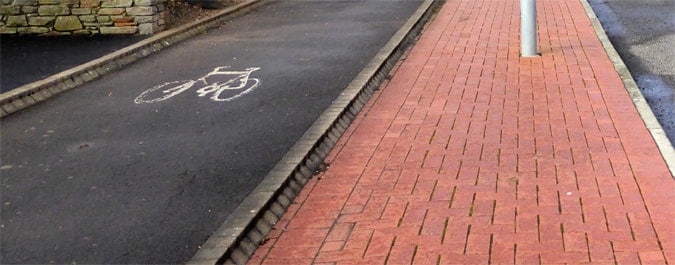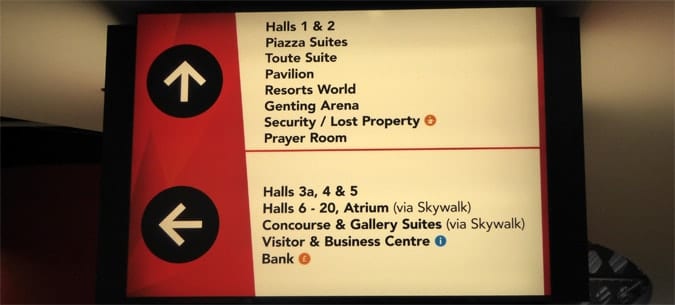Last Updated on June 19, 2024
Signage makers and designers often place signs which are not, for example, so easily visible by those sitting in a wheelchair and with a lower angle of vision.
Designers might also incorrectly assume the routes which a user needs to take.
On arriving in an airport, a retired friend whose wife is wheelchair bound, on entering an airport instead of heading straight for the check-in area, they head for the ‘Special Assistance’ phone or desk (if there is one).
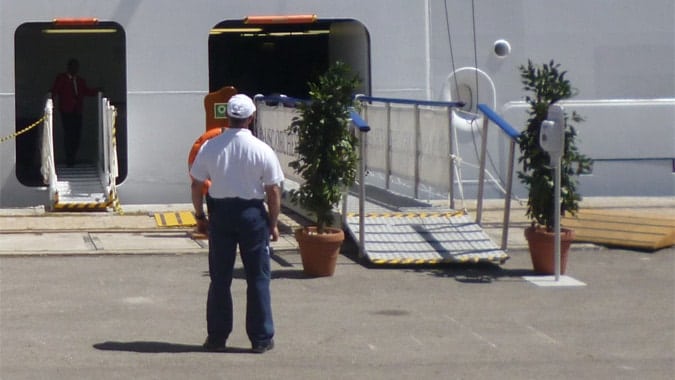
The assumptions, in other words, that we might make about a route and how others wayfind, is not always as we might expect.
So let us look at some of the considerations which, I suggest, ought to be made when considering the wayfinding needs of wheelchair users (and if you have anything to add, please email me at paul (at) travelwayfinding.com)

Table of Contents
Signage Design for Improving DDA Accessibility
Signage tends, for the most part, to be designed for adults travelling, but wheelchair-bound travellers tend to be sat lower at the height a child might be viewing from.
Signs which are placed too high can be hard to see. Signs which are, on the other hand, positioned too low, can become hidden when others stand in front of the signs (even when the signs are above the head height of the person blocking the sign).
Signs positioning should take into consideration all users of a travel space.
Accessibility problems can include ramps which are simply too steep to use, lift (elevator in American) buttons which are too high to reach and travel areas and spaces which are simply too narrow to turn around in.
There can be many barriers which disabled travellers are faced with and experience, and which are so often overlooked by planners.
Effective and visible signage also needs to exist to efficiently guide those in need of guidance and navigation to the direct route needed.
In designing a wayfinding system for able-bodied travellers, it can all too easily be forgotten that the escalator or stairs are simply unusable for some.
Are alternative ways of getting onto another floor clear for those with mobility issues?
Whilst the temptation by planners is to put the most effort into moving the masses, travellers with disabilities and accessibility problems have as much right to travel as any of us.
So much so that there are certain rules in countries such as in the U.S and in the European Union, for protecting the rights of disabled travellers to get from A to B, with the right help.
The Equality and Human Rights Commission are one such organisation that fights for the mobility rights of all.
The most significant convention to be aware of as a travel service provider is the ‘Convention on the Rights of Persons with Disabilities‘.
Staff Training for Improving DDA Accessibility
One of the most easily overlooked issues for travel service providers is training staff in how to best help wheelchair and mobility impaired travellers and their equipment.
It is not unknown for example, for wheelchairs to be mishandled and for the chairs to be broken on arrival at a destination airport.
It is also not unknown also for one’s wheelchair to be lost by an airline, or for the chair to come back incorrectly re-assembled having been stored in the hold of an aeroplane.
Being the centre of attention from other travellers because badly trained staff are unfamiliar with best practices for passengers who need assistance, is never a fair situation for the passenger.
Yet we hear of many situations of embarrassment caused to disabled passengers because of poor training.
Travel Space
“It is the disabling nature of socially constructed barriers that transforms them (people with impairments) into a person with disability” (Small et al, 2012)
Hotels that market themselves as disabled-friendly quite often are not.
From interviews with 20 mobility-impaired holidaymakers, one classic example is a hotel lift that could certainly fit a wheelchair inside it, but there was a large steep that needed to be navigated in order to enter the lift. Such stories are quite common!
Missing or non-existent wheelchairs in arrival airports or by airlines is another common issue I heard in talking with people.
Designers and urban planners can help in some respects and the creation of pedestrianised and flat areas such as in city centre streets can be a great help.
Trying to push or navigate a wheelchair along a busy and very narrow city street can be an utter nightmare for those involved.
The use of space is vital for incorporating the needs of all users.
Given that previous reports have shown that disabled travellers are often disproportionately loyal to those companies which manage to provide for their needs, it is hopefully worth the time both ethically and commercially for travel companies, to begin to better meet the needs of mobility-impaired travellers.
Certainly, a lot has been achieved in the last 10 years, but much more can be done.
Toilets
When travelling long distances, the extra difficulty in using public toilets, particularly on an airline, creates further problems for disabled users.
Whilst not all issues can be perfectly provided for, ensuring that disabled toilets always exist close to departure areas such as close to an airport departure gate is invaluable.
The report by Small et al (see link earlier in this post) showed that in her own interviews, some travellers were found to dehydrate themselves before travelling in order to overcome this problem of using toilets.
Certainly, though, airport designers and owners and designers of other travel locations should take great care to make the travel process as easier as possible.
Time
Time is another important factor that travel providers need always to consider for disabled navigators.
A route to be navigated might not be long distance-wise, but with security and other situations to deal with, whilst on a trip as a wheelchair user, the resource of time can be valuable.
Many airlines only allow us to check in only two hours before a flight.
Consideration needs to be given to the time resources given.

Online Information
Many wheelchair users and those with disabilities prefer the term ‘accessible travel’ but the problem online is that ‘accessibility’ is used for website access for those with disabilities i.e. it refers to access through large font sizes on screen or through speech provision (see the Bristol Airport website to see an example).
So I am hesitant to use the term accessible in order to avoid confusion, particularly in this section.
Final Thoughts
We have a duty to make travel something which is open to everyone in society and that includes not only those with physical ailments but also, of course, those who might otherwise be socially excluded, such as because of age, income or for other reasons. Improving DDA Accessibility, in other words, is essential.
There is clearly a lot more that can be done and often at very little cost, such as shown above in talking about using the online provision to help in trip planning and information provision.
One way in which travel service providers can greatly help disabled tourists is to provide as much help as possible also online, to aid in the pre-planning for the trip.
This should certainly not come at the expense of the use of great signage, use of space, well-trained staff and the other necessary aid required in travel situations as they happen.
Having printable maps which, for example, highlight all ‘Special Assistance desks’, which detail exactly where the disabled car parking spaces are, where the lifts are and detail anything that can further assist those in need of mobility help, is a relatively easy and yet enormously helpful way to help.
I would propose that every airport, airline and travel provider have a section on their website entitled ‘Mobility Assistance’. (Not accessible travel to avoid the aforementioned confusion with website accessibility and usability).
The information presently available on most websites including on the main UK airport websites, can greatly be improved on to date.
Academic studies in the past have shown that pre-planning has a higher level of importance for disabled travellers, because of the potential for something to go wrong and because of the considerations which need to be made.
Dr Paul Symonds has a PhD in Wayfinding from Cardiff Metropolitan University in the UK. Paul works with the signage industry, airports and other locations providing wayfinding audits, consultancy and training.

